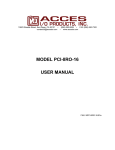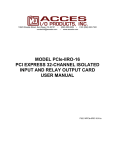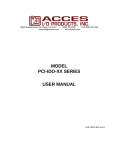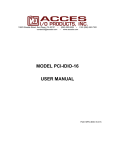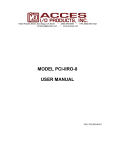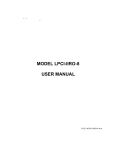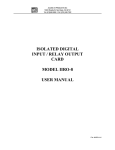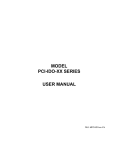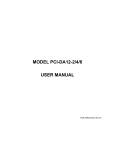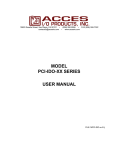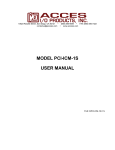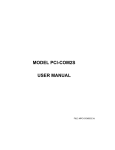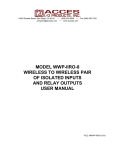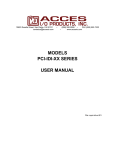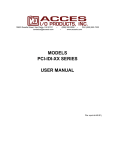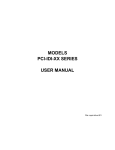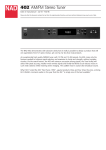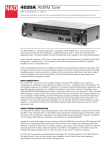Download MODEL PCI-IIRO-16 USER MANUAL
Transcript
MODEL PCI-IIRO-16
USER MANUAL
FILE: MPCI-IIRO-16.B1e
Notice
The information in this document is provided for reference only. Portwell does not assume any liability
arising out of the application or use of the information or products described herein. This document may
contain or reference information and products protected by copyrights or patents and does not convey
any license under the patent rights of Portwell, nor the rights of others.
IBM PC, PC/XT, and PC/AT are registered trademarks of the International Business Machines
Corporation.
Printed in USA. Copyright 2001, 2005 by Portwell I/O Products Inc. All rights reserved.
WARNING!!
ALWAYS CONNECT AND DISCONNECT YOUR FIELD CABLING WITH
THE COMPUTER POWER OFF. ALWAYS TURN COMPUTER POWER
OFF BEFORE INSTALLING A CARD. CONNECTING AND
DISCONNECTING CABLES, OR INSTALLING CARDS INTO A SYSTEM
WITH THE COMPUTER OR FIELD POWER ON MAY CAUSE DAMAGE
TO THE I/O CARD AND WILL VOID ALL WARRANTIES, IMPLIED OR
EXPRESSED.
2
Manual PCI-IIRO-16
Warranty
Prior to shipment, Portwell equipment is thoroughly inspected and tested to applicable specifications.
However, should equipment failure occur, Portwell assures its customers that prompt service and support
will be available. All equipment originally manufactured by Portwell which is found to be defective will be
repaired or replaced subject to the following considerations.
Terms and Conditions
If a unit is suspected of failure, contact Portwell' Customer Service department. Be prepared to give the
unit model number, serial number, and a description of the failure symptom(s). We may suggest some
simple tests to confirm the failure. We will assign a Return Material Authorization (RMA) number which
must appear on the outer label of the return package. All units/components should be properly packed for
handling and returned with freight prepaid to the Portwell designated Service Center, and will be returned
to the customer's/user's site freight prepaid and invoiced.
Coverage
First Three Years: Returned unit/part will be repaired and/or replaced at Portwell option with no charge for
labor or parts not excluded by warranty. Warranty commences with equipment shipment.
Following Years: Throughout your equipment's lifetime, Portwell stands ready to provide on-site or in-plant
service at reasonable rates similar to those of other manufacturers in the industry.
Equipment Not Manufactured by Portwell
Equipment provided but not manufactured by Portwell is warranted and will be repaired according to the
terms and conditions of the respective equipment manufacturer's warranty.
General
Under this Warranty, liability of Portwell is limited to replacing, repairing or issuing credit (at Portwell
discretion) for any products which are proved to be defective during the warranty period. In no case is Portwell
liable for consequential or special damage arriving from use or misuse of our product. The
customer is responsible for all charges caused by modifications or additions to Portwell equipment not
approved in writing by Portwell or, if in Portwell opinion the equipment has been subjected to abnormal
use. "Abnormal use" for purposes of this warranty is defined as any use to which the equipment is
exposed other than that use specified or intended as evidenced by purchase or sales representation.
Other than the above, no other warranty, expressed or implied, shall apply to any and all such equipment
furnished or sold by Portwell.
3
Manual PCI-IIRO-16
Table of Contents
Chapter 1: Introduction................................................................................................. 5
Specification .............................................................................................................. 6
Figure 1-1: Block Diagram................................................................................................................... 7
Chapter 2: Installation................................................................................................... 8
Chapter 3: Address Selection .................................................................................... 10
Chapter 4: Programming ............................................................................................ 11
Chapter 5: Connector Pin Assignments.................................................................... 13
Table 6-1: Connector Pin Assignments ............................................................................................. 13
Table 6-2: Breakout Cable Pin Assignments..................................................................................... 14
4
Manual PCI-IIRO-16
Chapter 1: Introduction
The card is a half size card that provides isolated input and output interface for PCI-Bus computers. The
card has sixteen optically-isolated inputs and sixteen electro-mechanical relay outputs for monitoring and
controlling DC or AC signals. An interrupt can be generated when any of the inputs change state to free
up computer resources by eliminating the need for polling. Fully sealed, low-resistance signal relays ideal
for use in telecommunications, security and computer peripheral equipment are used. The card occupies
eight consecutive 8-bit registers in I/O address space.
Inputs
ISOLATED INPUTS: The sixteen pairs of inputs can be driven by either AC or DC signals and are not
polarity sensitive. Input signals are rectified by a diode bridge and applied to the input of an opto-isolator.
A 470Ω resistor in series provides current limiting. Standard 12/24 VAC transformer outputs can be
accepted as well as DC voltages. The input voltage range is 5 to 24 volts (rms). External resistors
connected in series may be used to extend the input voltage range. The on/off state of the inputs is
determined by a software read.
FILTERS: Each input circuit contains a software controlled filter that has a 5 millisecond time constant.
For AC inputs the filter must be selected in order to maintain a DC level at the input register. The filter is
also valuable for use with slow DC input signals in a noisy environment. All filters are turned off at power
on, and are then enabled or disabled by software. The on/off status of the filters can also be read by
software.
INTERRUPTS: When enabled by software the card asserts an interrupt on the PCI-Bus when any of the
sixteen isolated inputs change state from either high to low, or low to high in DC mode and from signal to
no signal in AC mode. This interrupt capability is disabled at power on. Software commands are used to
enable, disable, clear and get status of the interrupt circuit.
Outputs
The sixteen electro-mechanical relay outputs are comprised of ten Form C SPDT type and six Form A
SPST (normally open) type. The relay contacts are rated at 0.5A at 125VAC, and 1A at 24VDC. All the
relays are turned off at power-on, and are then controlled by data bits written by software and latched.
The on/off status of the relays can be read back by software.
5
Manual PCI-IIRO-16
Specification
Isolated Inputs
•
Number of inputs:
Sixteen
•
Type:
Non-polarized, optically isolated from each other and
from the computer
•
Input voltage range:
5 to 24V DC or AC rms (50 to 10000 Hz)
•
Isolation*:
500V
•
Input Resistance:
470 ohms in series with two diodes and an LED
•
Response Time:
5 mSec w/filter
•
Interrupts:
PCI-INTA
Relay Outputs
•
Number of outputs:
Sixteen in two groups of eight. In each group 5 relays
are SPDT and 3 relays are SPST
•
Contact Type:
Single crossbar, Ag with Au clad. (Bifurcated contacts
optional)
•
Contact Rating:
1A max at 24VDC, 60VDC max, 0.5A at 125VAC max
•
Contact Resistance:
100 milliohm max
•
Contact Life:
5,000,000 min. (mech’l)
•
Operate time:
5 mSec max
•
Release Time:
5 mSec max
•
Isolation*:
1000V
•
Vibration:
10 to 55 Hz, 3.3 mm dbl amp; mech. dur. 1,000 m/s2
(approx 100G)
* Notes on Isolation:
Opto-Isolators, connector and relays are rated for at least 500V, but isolation
voltage breakdowns will vary and is affected by factors like cabling, spacing of pins,
spacing between traces on PCB, humidity, dust and other environmental factors. This is a
safety issue so a careful approach is required. For CE certification, isolation was
specified at 40V AC and 60V DC. The design intention was to eliminate the influence of
common mode. Use proper wiring techniques to minimize voltage between channels and
to ground. For example, when working with AC lines do not connect the hot side of the
line to an input.
Power Required
•
+5VDC
250mA min, 750mA max (all relays ON)
6
Manual PCI-IIRO-16
Environmental
•
Ambient Temperature:
Operating:
Storage:
0 °C. to +50 °C
-40 °C. to +85 °C
•
Humidity:
0 to 90% (non-condensing)
•
Weight:
Approx. 8 oz
•
Size:
6.80" long (173 mm)
Vcc
OP0, OP8
V cc
ISOLATED
INPUT 0
Vcc
ADDRESS AND
CONTROL
LOGIC
INPUTS 1-14
Vcc
INPUT
OUTPUT
REGISTERS
REGISTER
WITH
WITH
SWITCHABLE
READBACK
FILTERS
Vcc
Vcc
OP1, OP9
OP2, OP10
OP3, OP11
OP4, OP12
Vcc
OP5, OP13
Vcc
CHANGE-OFSTATE
DETECT
V cc
OP6, OP14
ISOLATED
INPUT 15
RESET
Vcc
OP7, OP15
FILTER
ENABLE
REGISTER
PCI BUS INTERFACE
COMPUTER PCI BUS
Figure 1-1: Block Diagram
7
Manual PCI-IIRO-16
Chapter 2: Installation
A printed Quick-Start Guide (QSG) is packed with the card for your convenience. If you’ve already
performed the steps from the QSG, you may find this chapter to be redundant and may skip forward to
begin developing your application.
The software provided with this card is on CD and must be installed onto your hard disk prior to use. To
do this, perform the following steps as appropriate for your operating system.
CD Software Installation
The following instructions assume the CD-ROM drive is drive “D”. Please substitute the appropriate drive
letter for your system as necessary.
DOS
1.
2.
3.
4.
Place the CD into your CD-ROM drive.
Type B- to change the active drive to the CD-ROM drive.
Type GLQR?JJ- to run the install program.
Follow the on-screen prompts to install the software for this board.
WINDOWS
1.
Place the CD into your CD-ROM drive.
2.
The system should automatically run the install program. If the install program does not run
promptly, click START | RUN and type BGLQR?JJ, click OK or press -.
3.
Follow the on-screen prompts to install the software for this board.
LINUX
1.
Please refer to linux.htm on the CD-ROM for information on installing under linux.
Caution! * ESD A single static discharge can damage your card and cause premature
failure! Please follow all reasonable precautions to prevent a static
discharge such as grounding yourself by touching any grounded
surface prior to touching the card.
8
Manual PCI-IIRO-16
Hardware Installation
1.
2.
3.
4.
5.
6.
7.
8.
9.
Do not install card into the computer until the software has been fully installed.
Turn OFF computer power AND unplug AC power from the system.
Remove the computer cover.
Carefully install the card in an available 5V or 3.3V PCI expansion slot (you may need to remove
a backplate first).
Inspect for proper fit of the card and tighten screws. Make sure that the card mounting bracket is
properly screwed into place and that there is a positive chassis ground.
Install an I/O cable onto the card’s bracket mounted connector.
Replace the computer cover and turn ON the computer which should auto-detect the card
(depending on the operating system) and automatically finish installing the drivers.
Run PCIfind.exe to complete installing the card into the registry (for Windows only) and to
determine the assigned resources.
Run one of the provided sample programs that was copied to the newly created card directory
(from the CD) to test and validate your installation.
The base address assigned by BIOS or the operating system can change each time new hardware is
installed into or removed from the computer. Please recheck PCIFind or Device Manager if the hardware
configuration is changed. Software you write can automatically determine the base address of the card
using a variety of methods depending on the operating system. In DOS, the PCI\SOURCE directory
shows the BIOS calls used to determine the address and IRQ assigned to installed PCI devices. In
Windows, the Windows sample programs demonstrate querying the registry entries (created by PCIFind
and NTIOPCI.SYS during boot-up) to determine this same information.
9
Manual PCI-IIRO-16
Chapter 3: Address Selection
This card uses I/O addresses offset from the base address assigned by the PCI bus. The address spaces
are defined in the programming section of this manual.
PCI architecture is Plug-and-Play. This means that the BIOS or Operating System determines the
resources assigned to PCI cards rather than the user selecting those resources with switches or jumpers.
As a result, you cannot set or change the card's base address or IRQ level. You can only determine what
the system has assigned.
To determine the base address that has been assigned, run the PCIFind utility program. This utility will
display a list of all the cards detected on the PCI bus, the addresses assigned to each function on each of
the cards, and the respective IRQs.
Alternatively, Windows systems can be queried to determine which resources were assigned. In these
operating systems, you can use either PCIFind, or the Device Manager utility from the System Properties
Applet of the control panel. The card is installed in the Data Acquisition class of the Device Manager list.
Selecting the card, clicking Properties, and then selecting the Resources Tab will display a list of the
resources allocated to the card.
The PCI bus supports 64K of I/O address space, so your card's addresses may be located anywhere in
the 0000h to FFFFh range. The card occupies eight consecutive 8 bit registers in I/O address space.
PCIFind uses the Vendor ID and Device ID to search for your card, then reads the base address and
IRQ. If you want to determine the base address and IRQ without using PCIFind, use the following
information:
The Vendor ID code is 494F (ASCII for "I/O")
The Device ID code for the card is 0F08
An example of how to locate PCI card resources is provided with in the PCI\SOURCE directory, under
your installation directory. This code runs in DOS, and uses the PCI defined interrupt BIOS calls to query
the PCI bus for card specific information. You will need the Device ID and Vendor ID listed above to use
this code.
10
Manual PCI-IIRO-16
Chapter 4: Programming
The base or starting address is assigned by the computers plug-and-play operating system during
installation and will fall on a eight byte boundary (see chapter 3).
The card’s read and write functions are as follows:
I/O Address
Read
Write
Base +0
Outputs 0 – 7
Outputs 0 – 7
Base +1
Inputs 0 – 7
Interrupt Clear
Base +2
Interrupt Enable
Interrupt Disable
Base +3
Filter Enable
Filter Disable
Base +4
Outputs 8 – 15
Outputs 8 – 15
Base +5
Inputs 8 – 15
Unused
Base +6
Interrupt Status
Unused
Base +7
Filter Status
Unused
Relay Outputs
At power-up, all relays are de-energized (normally-closed contacts). The relay outputs are controlled by
writing to the base address +0 and +4. Each bit within the bytes controls a specific relay. A "1" energizes
the corresponding relay and a "0" de-energizes it. The status of the relays can be determined at any time
by a read from base address +0 and +4.
Bit Position
D7
D6
D5
D4
D3
D2
D1
D0
Relay Low Byte
OP7
OP6
OP5
OP4
OP3
OP2
OP1
OP0
Relay High Byte
OP15
OP14
OP13
OP12
OP11
OP10
OP9
OP8
For example, if bit D5 is set to a 1 by writing 20 hex to the base address +0 the relay that controls OP5 is
energized, closing the associated normally-open contacts. All other relays would be de-energized and
their normally-closed contacts would be closed.
11
Manual PCI-IIRO-16
Isolated Inputs
Input states can be read from Base Address +1and +5. Each of the bits within the bytes corresponds to a
particular isolated input. A "1" signifies that the input is energized and a "0" signifies that the input is deenergized.
Bit Position
D7
D6
D5
D4
D3
D2
D1
D0
Input Low Byte
IP7
IP6
IP5
IP4
IP3
IP2
IP1
IP0
IP10
IP9
IP8
Input High Byte IP15 IP14 IP13 IP12 IP11
FILTERS: Sometimes it is necessary to slow down the card's response to eliminate noise spikes on DC
inputs in industrial environments or to convert sinusoidal AC inputs. The 5 mSec filter can be enabled for
all inputs by a software read from base address +3 or disabled by a write of any value to base address
+3. The status of the filters can be read back from base address +7. A value of FF hex indicates the filters
are active and a value of 00 hex indicates they are disabled.
INTERRUPTS: The card supports interrupts. The interrupt level is assigned by the plug-and-play
operating system. The assigned interrupt level can be viewed when PCIFind.EXE is run (see chapter 3).
The card’s interrupt capability makes it is unnecessary to continuously poll inputs (by reading at base
address +1 and +5) to detect when an input state has changed. To enable interrupts read from base
address +2. To disable interrupts, write any value to base address +2. To clear an interrupt write any
value to base address +1. The user must include the clear instruction in the interrupt service routine
software. For shared interrupt applications the card has an IRQ status byte that can be read from base
address +6. Bits 0 and 1 set indicate interrupts are enabled, bit 2 set indicates an IRQ has been
generated, bits 3 thru 7 will always read 0.
Programming Examples
No driver software is provided with because programming is very simple and can be accomplished most
efficiently using direct I/O instructions. The following examples are in C but are readily translated into
other languages:
Example:
Turn on OP0 and OP7
Base=0xF300;
outportb(Base, 0x81);
Example:
Read back the state of the relays
X=inportb(Base);
printf("%02x");
Example:
//Base I/O address
//relay register data to X
//display results
Read the digital inputs
Y=inportb(Base+1);
//digital input register to Y
12
Manual PCI-IIRO-16
Chapter 5: Connector Pin Assignments
Digital I/O signals are connected to the card via a 78-pin D type connector that extends through the back
of the computer case. The mating connector is an AMP 748368-1 or equivalent. We optionally provide a
breakout cable that divides the 78-pin I/O connector down to two 37-pin D type connectors. See the
following page for information about termination solutions.
Pin
1
2
3
4
5
6
7
8
9
10
11
12
13
14
15
16
17
18
19
20
21
22
23
24
25
26
27
28
29
30
31
32
33
34
35
36
37
38
39
Name
IP7
IP6
IP5
IP4
IP3
IP2
IP1
IP0
OP7(C)
OP6(C)
OP5(C)
OP4(NC)
OP4(NO)
OP3(C)
OP2(NC)
OP2(NO)
OP1(C)
OP0(NC)
OP0(NO)
Function
Pin
Name
40
IP15
41
IP14
42
IP13
43
IP12
Isolated Input
44
IP11
45
IP10
46
IP9
47
IP8
48
OP15(C)
49
OP14(C)
50
OP13(C)
51
OP12(NC)
52
OP12(NO)
Relay Contact
53
OP11(C)
54
OP10(NC)
55
OP10(NO)
56
OP9(C)
57
OP8(NC)
58
OP8(NO)
Not Used
59
IP7
60
IP15
IP6
61
IP14
IP5
62
IP13
IP4
63
IP12
Isolated Input
IP3
64
IP11
IP2
65
IP10
IP1
66
IP9
IP0
67
IP8
OP7(NO)
68
OP15(NO)
OP6(NO)
69
OP14(NO)
OP5(NO)
70
OP13(NO)
OP4(C)
71
OP12(C)
OP3(NC)
72
OP11(NC)
Relay Contact
OP3(NO)
73
OP11(NO)
OP2(C)
74
OP10(C)
OP1(NC)
75
OP9(NC)
OP1(NO)
76
OP9(NO)
OP0(C)
77
OP8(C)
Not Used
78
Table 6-1: Connector Pin Assignments
13
Manual PCI-IIRO-16
Termination Solutions
The breakout solution for the card involves a “Y” cable that terminates into two identically pinned out
37DBF connectors. As part of a kit, these connectors plug into the STB-37 screw terminal cards, which
easily mount into a length of SNAPTRACK. The pinout of each leg when plugged into an STB-37 is
identical to that of the eight channel ISA and PCI Isolated Input/Relay Output Cards. The “Y” cable is six
(6) feet long on each leg.
“1-39" Cable
PIN NAME FUNCTION
PIN
“40-78" Cable
NAME
FUNCTION
1
IP7
1
IP15
2
IP6
2
IP14
3
IP5
3
IP13
4
IP4
4
IP12
5
IP3
5
IP11
6
IP2
6
IP10
7
IP1
7
IP9
8
IP0
8
IP8
Isolated Input
9
OP7(C)
9
OP15(C)
10
OP6(C)
10
OP14(C)
11
OP5(C)
11
OP13(C)
12
OP4(NC)
12
OP12(NC)
13
OP4(NO)
13
OP12(NO)
14
OP3(C)
14
OP11(C)
15
OP2(NC)
15
OP10(NC)
16
OP2(NO)
16
OP10(NO)
17
OP1(C)
17
OP9(C)
18
OP0(NC)
18
OP8(NC)
19
OP0(NO)
19
OP8(NO)
20
IP7
20
IP15
21
IP6
21
IP14
22
IP5
22
IP13
23
IP4
23
IP12
24
IP3
24
IP11
25
IP2
25
IP10
26
IP1
26
IP9
27
IP0
27
IP8
28
OP7(NO)
28
OP15(NO)
29
OP6(NO)
29
OP14(NO)
30
OP5(NO)
30
OP13(NO)
31
OP4(C)
31
OP12(C)
32
OP3(NC)
32
OP11(NC)
33
OP3(NO)
33
OP11(NO)
Relay Contact
Isolated Input
Relay Contact
34
OP2(C)
34
OP10(C)
35
OP1(NC)
35
OP9(NC)
36
OP1(NO)
36
OP9(NO)
37
OP0(C)
37
OP8(C)
Isolated Input
Relay Contact
Isolated Input
Relay Contact
Table 6-2: Breakout Cable Pin Assignments
14
Manual PCI-IIRO-16
Customer Comments
If you experience any problems with this manual or just want to give us some feedback, please email us
at: [email protected]. Please detail any errors you find and include your mailing address so that
we can send you any manual updates.
15
Manual PCI-IIRO-16















